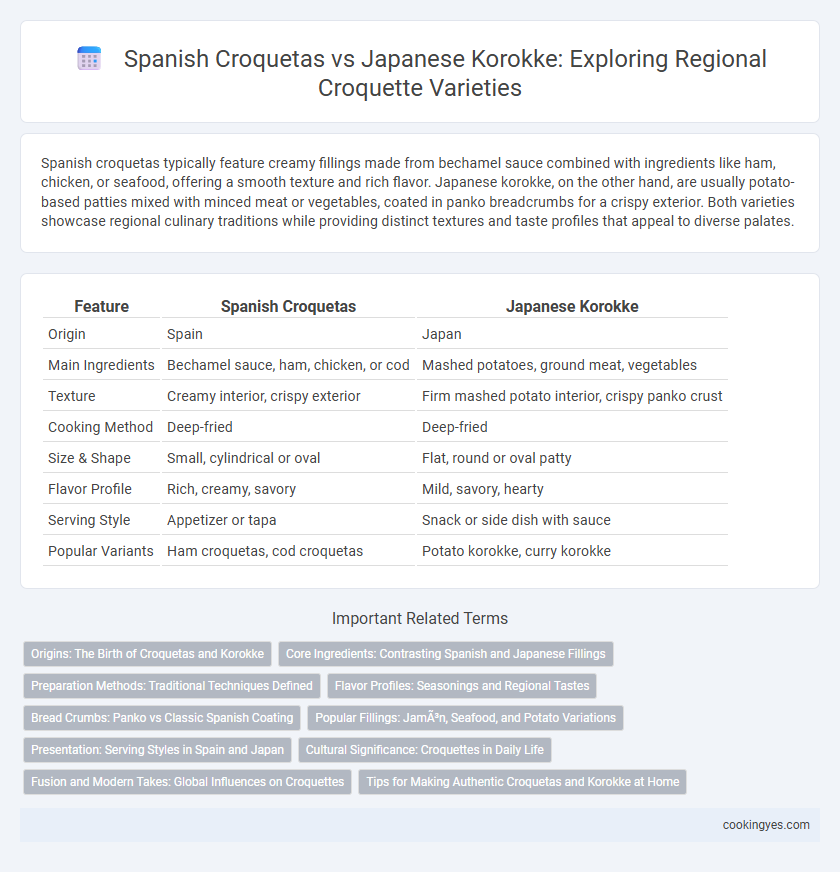Spanish croquetas typically feature creamy fillings made from bechamel sauce combined with ingredients like ham, chicken, or seafood, offering a smooth texture and rich flavor. Japanese korokke, on the other hand, are usually potato-based patties mixed with minced meat or vegetables, coated in panko breadcrumbs for a crispy exterior. Both varieties showcase regional culinary traditions while providing distinct textures and taste profiles that appeal to diverse palates.
Table of Comparison
| Feature | Spanish Croquetas | Japanese Korokke |
|---|---|---|
| Origin | Spain | Japan |
| Main Ingredients | Bechamel sauce, ham, chicken, or cod | Mashed potatoes, ground meat, vegetables |
| Texture | Creamy interior, crispy exterior | Firm mashed potato interior, crispy panko crust |
| Cooking Method | Deep-fried | Deep-fried |
| Size & Shape | Small, cylindrical or oval | Flat, round or oval patty |
| Flavor Profile | Rich, creamy, savory | Mild, savory, hearty |
| Serving Style | Appetizer or tapa | Snack or side dish with sauce |
| Popular Variants | Ham croquetas, cod croquetas | Potato korokke, curry korokke |
Origins: The Birth of Croquetas and Korokke
Spanish Croquetas originated in the 19th century as a luxurious dish in French haute cuisine before becoming a staple of Spanish tapas, characterized by creamy bechamel dough filled with ham or chicken. Japanese Korokke emerged in the Meiji era, inspired by French croquettes but adapted with local ingredients like mashed potatoes and ground meat to suit Japanese tastes. Both croquettes reflect their regional histories, with Spanish Croquetas emphasizing rich, creamy textures and Japanese Korokke showcasing a crispy, breaded exterior and hearty fillings.
Core Ingredients: Contrasting Spanish and Japanese Fillings
Spanish croquetas typically feature a creamy bechamel base combined with finely chopped ham, chicken, or cod, creating a rich and savory center. Japanese korokke uses mashed potatoes or ground meat mixed with onions, offering a hearty, textured filling that is both mild and comforting. The core ingredients highlight regional taste preferences: Spain's emphasis on dairy-infused, delicate fillings contrasts with Japan's potato-based, robust croquette varieties.
Preparation Methods: Traditional Techniques Defined
Spanish croquetas feature a smooth, thick bechamel base infused with ham or chicken, formed into small cylinders, then coated with breadcrumbs and fried to golden perfection. Japanese korokke uses mashed potatoes mixed with ground meat or vegetables, shaped into patties, battered with flour, egg, and panko, then deep-fried to achieve a crispy exterior. Both preparation methods reflect traditional culinary techniques emphasizing texture contrast and regional ingredient adaptation.
Flavor Profiles: Seasonings and Regional Tastes
Spanish croquetas feature creamy bechamel fillings seasoned with nutmeg, garlic, and cured ham or seafood, reflecting the rich, savory flavors characteristic of Spanish cuisine. Japanese korokke typically incorporate mashed potatoes mixed with ground meat or vegetables, seasoned with soy sauce, mirin, and sometimes curry spices, offering a balance of sweet and umami tastes distinctive to Japan. Regional preferences influence seasoning choices, with Spanish croquetas leaning towards robust, aromatic ingredients while Japanese korokke emphasize subtle sweetness and savory depth.
Bread Crumbs: Panko vs Classic Spanish Coating
Spanish croquetas traditionally feature a smooth bechamel filling coated in fine, classic breadcrumbs that create a delicate, crisp exterior. Japanese korokke uses coarser panko breadcrumbs, delivering a lighter, airier crunch that contrasts with the soft interior. The choice of breadcrumbs significantly influences texture, with panko providing enhanced crispness and reduced oil absorption compared to traditional Spanish coatings.
Popular Fillings: Jamón, Seafood, and Potato Variations
Spanish croquetas often feature creamy bechamel fillings with jamon serrano, seafood like cod or shrimp, and vegetable varieties such as spinach. Japanese korokke typically use mashed potatoes combined with ground meat, seafood, or vegetables, creating a crispy, breaded exterior. Both regional varieties showcase distinct textures and flavors, with Spanish croquetas emphasizing rich, smooth centers and Japanese korokke highlighting hearty, crispy bites.
Presentation: Serving Styles in Spain and Japan
Spanish croquetas are typically served as small, bite-sized tapas with a crispy golden exterior and creamy filling, often presented on ceramic plates accompanied by a wedge of lemon or a side of alioli. Japanese korokke are generally larger patties with a crunchy panko breadcrumb coating, served individually on a plate or as part of a bento box, sometimes drizzled with tonkatsu sauce and paired with shredded cabbage. The Spanish style emphasizes shared, social dining with elegant plating, while the Japanese approach highlights individual portions with a balanced meal presentation.
Cultural Significance: Croquettes in Daily Life
Spanish croquetas embody a rich culinary tradition rooted in tapas culture, often enjoyed as a shared dish during social gatherings or family meals, highlighting their role in fostering community and conviviality. Japanese korokke, adapted from Western croquettes, serve as popular comfort food and convenient street snacks, symbolizing practical everyday eating with a focus on simplicity and versatility. Both varieties reflect cultural values through their ingredients and consumption contexts, illustrating croquettes as more than food but cultural expressions embedded in daily life.
Fusion and Modern Takes: Global Influences on Croquettes
Spanish croquetas blend creamy bechamel with fillings like jamon or cod, offering rich, smooth textures, while Japanese korokke feature mashed potatoes or ground meat with a crisp panko coating, emphasizing crunchiness and heartiness. Modern fusion croquettes incorporate global ingredients such as truffle, cheese, or kimchi, reflecting cross-cultural culinary innovation and expanding traditional flavor profiles. These evolving varieties showcase the adaptability of croquettes, merging European and Asian influences to create globally inspired street food and gourmet options.
Tips for Making Authentic Croquetas and Korokke at Home
Achieving authentic Spanish croquetas requires a creamy bechamel base blended with finely chopped jamon or chicken, seasoned with nutmeg and salt, then coated in panko breadcrumbs for a crisp exterior. Japanese korokke demands mashed potatoes mixed with ground beef or vegetables, shaped into patties, dredged in flour, egg, and panko, and deep-fried until golden brown. Keeping the filling smooth for croquetas and avoiding over-mixing potatoes for korokke ensures perfect texture and flavor in these regional croquette varieties.
Spanish Croquetas vs Japanese Korokke for regional croquette variety Infographic

 cookingyes.com
cookingyes.com